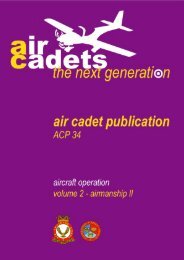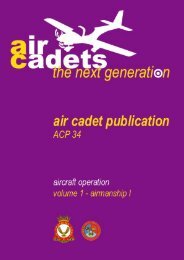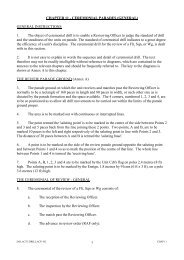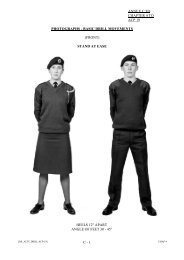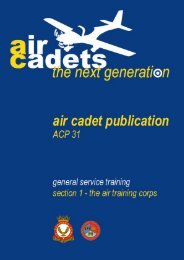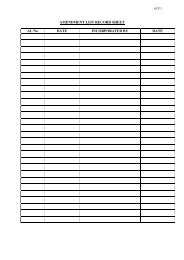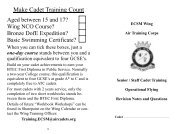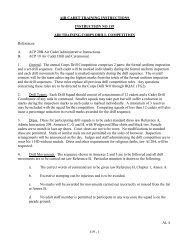Leading Cadet ECSM Wing Revision Guide - 967 Air Cadets
Leading Cadet ECSM Wing Revision Guide - 967 Air Cadets
Leading Cadet ECSM Wing Revision Guide - 967 Air Cadets
Create successful ePaper yourself
Turn your PDF publications into a flip-book with our unique Google optimized e-Paper software.
Battle of Britain Flight Transports<br />
PAR stands for Precision Approach Radar. Using<br />
radar the ground controller is able to see the aircraft’s<br />
position relative to the runway centre line and correct<br />
glideslope and pass this information to the pilot until<br />
he is able to land visually. This procedure is called a<br />
ground controlled approach (GCA).<br />
<strong>Air</strong>ways<br />
<strong>Air</strong>ways are a network of imaginary ‘tunnels’ in the<br />
air. They provide a safe means of moving large numbers<br />
of aircraft under air traffic’s control. Any aircraft,<br />
whether military or civilian may use them<br />
providing they comply with the requirements:<br />
1. The pilot must have a valid instrument rating.<br />
2. The aircraft is fitted with appropriate radio and<br />
navigational equipment.<br />
3. The flight is made in accordance with the rules.<br />
<strong>Air</strong>ways are between 10 and 20 nautical miles wide,<br />
the centres of the airways being marked by a series of<br />
radio navigation beacons.<br />
Contact with ATCC must be established before an<br />
aircraft can enter or join an airway.<br />
<strong>Air</strong>craft flying outside controlled airspace may only<br />
cross an airway, either by flying underneath it, providing<br />
the base of the airway is above ground, or<br />
with clearance and radar control from the appropriate<br />
ATCRU.<br />
What does the abbreviation PAR represent?<br />
a) Pilot Applied Radar.<br />
b) Preplanned Approach to Runway.<br />
c) Pilot Aided Radar.<br />
d) Precision Approach Radar.<br />
What is PAR used for?<br />
a) Guiding the aircraft down the correct glide slope towards<br />
touchdown.<br />
b) Guiding the pilot onto the runway with no assistance<br />
from the controller.<br />
c) Giving the pilot directions when flying between airfields.<br />
d) Allowing the pilot to get a fix on the aircraft’s position.<br />
Which of the following are requirements for using an airway?<br />
(More than one answer.)<br />
a) The flight is made during daylight hours.<br />
b) The flight is made in accordance with the rules.<br />
c) The aircraft is fitted with appropriate radio and navigational<br />
equipment.<br />
d) The aircraft must not enter cloud.<br />
e) The correct speed at time of joining.<br />
f) The pilot has a valid instrument rating.<br />
In nautical miles, what is the range of widths of airways?<br />
a) 1 to 5. b) 5 to 10. c) 10 to 20. d) 20 to 30.<br />
<strong>Air</strong>ways are marked by:<br />
a) National grid power lines.<br />
b) Lights at certain points along the ground.<br />
c) A series of radio navigation beacons.<br />
d) Radio signals from air traffic control centres.<br />
The markers in the previous question are positioned along:<br />
a) The outer edge of the airway.<br />
b) The centre of the airway.<br />
c) Each side of the airway.<br />
d) The inner edge of the airway.<br />
ATCC provides which service in connection with airways?<br />
a) Clearance to fly over the top.<br />
b) Planning of route.<br />
c) Permission to takeoff.<br />
d) Clearance to use airway.<br />
If an aircraft wishes to cross an airway, which of the following<br />
is permitted? (More than one answer!)<br />
a) <strong>Air</strong>craft can be flown through under radar control from<br />
the ATCRU.<br />
b) <strong>Air</strong>craft must join airway, fly along it and turn off<br />
when instructed by ATC.<br />
c) <strong>Air</strong>craft may fly through without clearance provided it<br />
is clear of cloud.<br />
d) Provided there is no traffic in that part of the airway it<br />
can fly through without clearance.<br />
e) Providing the base of the airway is above ground, the<br />
aircraft can be flown underneath without clearance.<br />
f) Providing there is no cloud, the aircraft can fly through<br />
at any point without clearance.<br />
g) Providing the pilot has an instrument rating, he can fly<br />
through without clearance.<br />
22<br />
19



